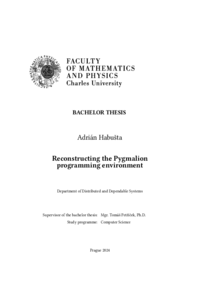Reconstructing the Pygmalion programming environment
Rekonstrukce programovacího prostředí Pygmalion
bachelor thesis (DEFENDED)

View/
Permanent link
http://hdl.handle.net/20.500.11956/192915Identifiers
Study Information System: 261855
Collections
- Kvalifikační práce [11326]
Author
Advisor
Referee
Šefl, Vít
Faculty / Institute
Faculty of Mathematics and Physics
Discipline
Computer Science with specialisation in Programming and Software Development
Department
Department of Distributed and Dependable Systems
Date of defense
5. 9. 2024
Publisher
Univerzita Karlova, Matematicko-fyzikální fakultaLanguage
English
Grade
Excellent
Keywords (Czech)
programování demonstrací|historie programování|pygmalion|programovací prostředíKeywords (English)
programming by demonstration|history of programming|pygmalion|programming environmentsTato práce se zaměřuje na rekonstrukci podmnožiny Pygmalionu, progra- movacího systému, který byl ve své době revoluční díky použití programo- vání pomocí demonstrací a ikonického (vizuálního) programování. Vzhledem k tomu, že v současnosti není k dispozici žádná spustitelná verze tohoto soft- waru, je rekonstrukce Pygmalionu klíčová pro zachování těchto jedinečných myšlenek a umožnění interakce uživatelů s nimi. Naše rekonstrukce se zamě- řuje na jeden příklad z původní práce, který přibližně ukazuje, jak vytvořit novou ikonu schopnou vypočítat faktoriál celého čísla. Použili jsme itera- tivní metodiku, abychom se dozvěděli více o původním systému a zároveň vytvořili dva po sobě jdoucí návrhy pro naši rekonstrukci systému. Tímto postupem jsme získali hlubší znalosti o vlastnostech Pygmalionu a vytvořili jsme software, který splňuje náš cíl - obnovit příklad faktoriálu.
This thesis focuses on reconstructing a subset of Pygmalion, a program- ming system that was revolutionary for its time, due to its use of program- ming by demonstration and iconic (visual) programming. With no current runnable version of the software available, reconstructing Pygmalion is cru- cial to preserve these unique ideas and allow users to interact with them. Our reconstruction focuses on one example from the original Pygmalion thesis, which loosely shows how to create a new icon capable of computing the facto- rial of an integer. We used an iterative methodology to learn more about the original system while creating two consecutive designs for our reconstruction of the system. Through this process, we gained deeper knowledge of Pyg- malions features, and created software that fulfills our goal of recreating the factorial example.
